
Head of an Akkadian Ruler
Akkadian (2250 BCE), bronze, 30.7 cm, Akkad
do not know where capital of Akkad (maybe Akkad itself?) is
Sargon emperor
ritual mutilation of senses: eyes and ear --> rely on eyes and ears (damage ability of sight and hearing)
done by later people, not Akkadians --> detract rulers power
perfect patterned beard --> masculinity / virility / power
mask like quality
woven hair is marking him as a ruler --> looks like a crown (Princess Leia)

Sargon of Akkad
Akkadian (2334 - 2284 BCE), diorite, Akkad
cuneiform --> sumerian script (not sumerian langauge)

Victory Stele of Sargon
Akkadian, diorite, Akkad
helmet and hair = masculinity

Enheduanna Disk
Akkadian (2350 - 2300 BCE), limestone and calcite, 25 cm, Akkad
wrote first poem
first women (and person WOOOHOOO) to sign their name
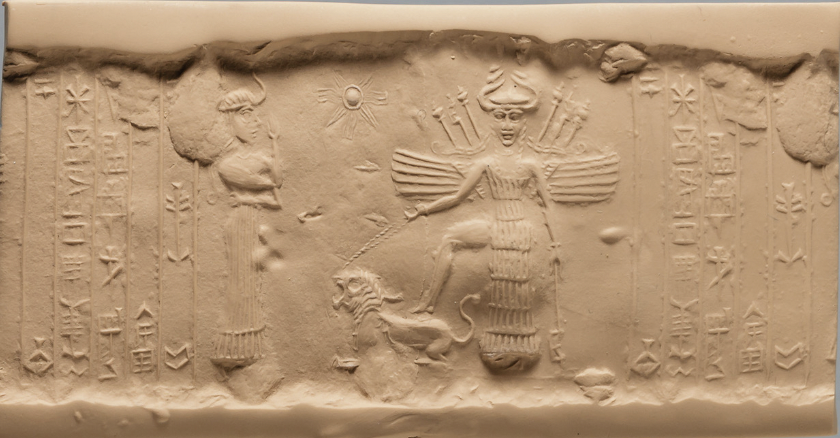
Cylinder Seal
Akkadian (2350 - 2150 BCE), limestone, Akkad
portrait of innana
innana scares akkadians
innana has wings, full weapons on back, horns = power (more horns = more powerful deity)
innana = goddess of love and war --> lion is her sacred animal because they are big and scary but protect their cubs (defensible / fertility)
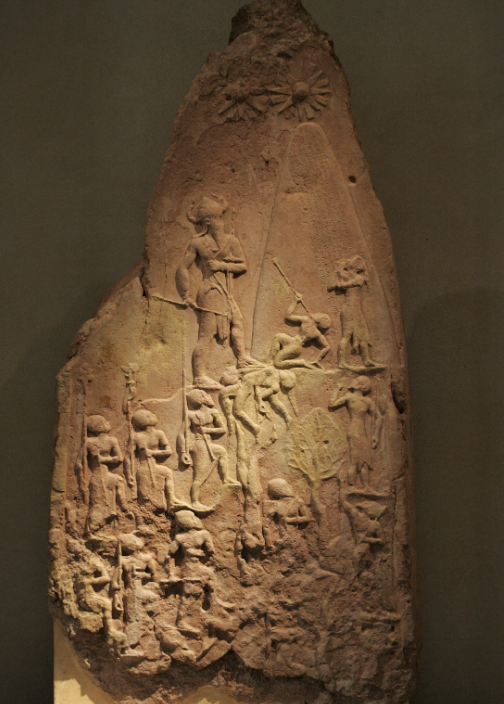
Stele of Naram-Sin
Akkadian (2250 BCE), limestone, 200 cm (6'7"), Akkad
hieratic scale --> Narrar-Sin is bigger and higher than everyone else = more important
one set of horns
Elammites steal it to appropriate Naram-Sin's victory for their own --> like a trophy
original location is Sippar but it was found in Susa
Akkad is constantly expanding --> human based cultural destruction

proof that Naram-Sin Stele was stolen by Elammites

Nimrud (879 - 706 BCE)
Capital city of Assyirians

Great Ziggurat
Assyrian
Nimrud
Shalmaneser III
mud brick --> not well preserved

Lamassu
Assyrian (883 - 859 BCE), Palace of Ashurnasirpal II in Nimrud
apotropaic --> guardians of the throne room (intimidate you and keep bad things away)
one is a bull body, the other is a lion body
3 horns and five legs --> side it looks like walking with you, front it looks like they are standing still
ISIS destroys many artwork int his area

Relief depicting Ashurbanipal
Assyrian (669 - 631 BCE), Assyria
Ash has a hat on
Ash is hunting lions --> proves he is more powerful than a lion and intimidate enemies
but lions were pre-captured in order to let the king kill them --> king is actually weak

Ramses II
Dynasty 19 (1292 - 1189 BCE), granodiorite, Karnak Temple in Egypt
feminine --> was it more prominent and not ripped
Ramses will always look truthful and perfect
not intimidating --> face lacks emotion
presence = power --> calm but in control
child on the side (children are bald except for ponytail) --> hieratic scale = Ramses is most important
Ramses has 5 names (more names = more accomplishments) one being Ra ms sw, child of Ra, never lost a battle (lie)
graffiti under statue reads sema-tawy = unification of Egypt

Ramses II --> more specifically the crown
no physical representation of crown --> know it exists because of statues
likely valuable and stolen
would've been woven out of reeds (basket like)
khepresh = blue crown --> wear when go to war (Ramses wears this constantly)
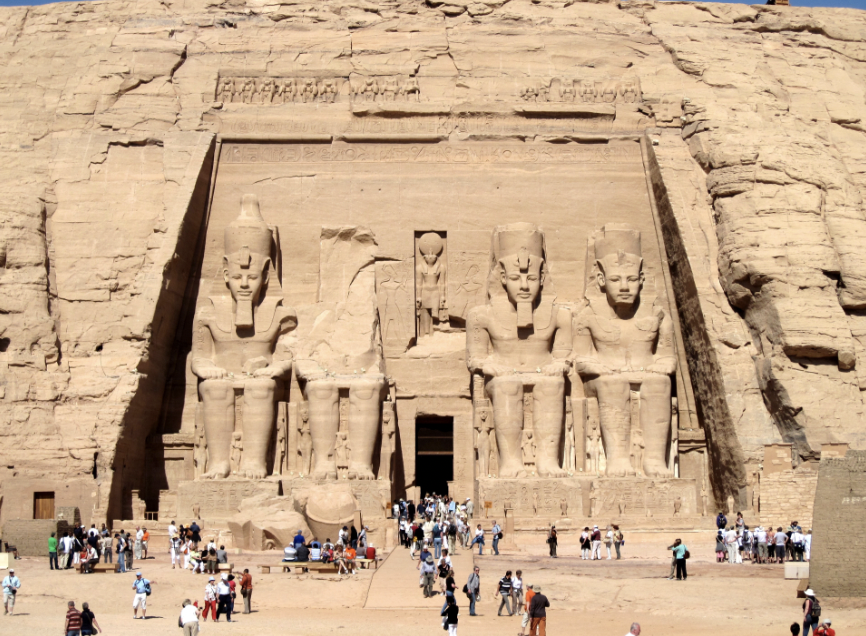
Temple of Ramses, beloved of Amun
19th Dynasty (1264 - 1244 BCE), 67 ft tall, Egypt
dedicated to Amum = fertility, Ptah, Re-Horakhty, and Ramses II
all big statues are Ramses
moved Temple piece by piece (lifted and reassembled) --> build a fake mountain for it and tried to maintain as much of the go location as possible
wife on right leg and child in between --> hieratic scale
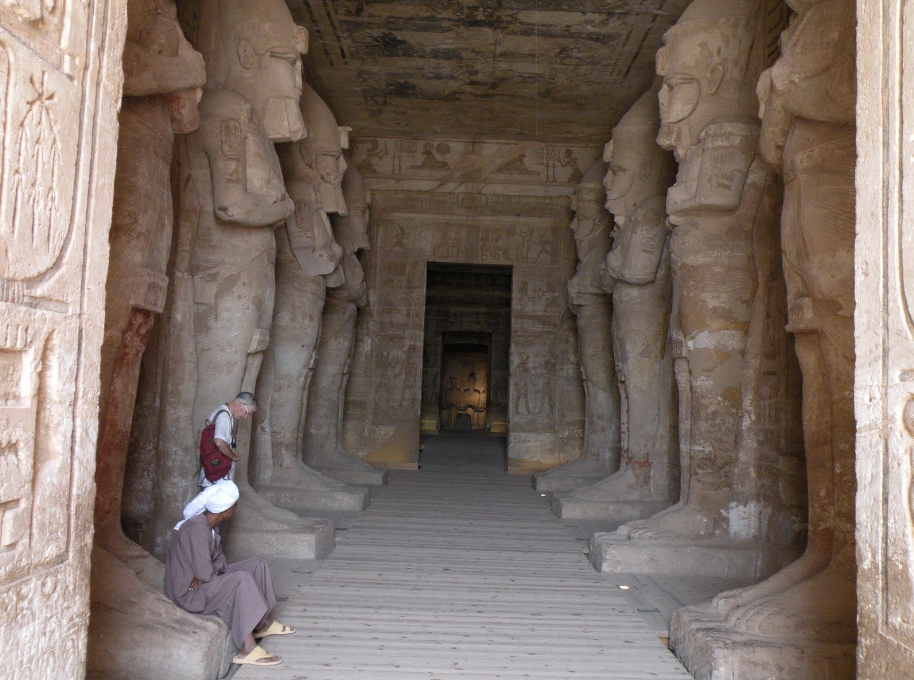
Great Hall of the Temple of Ramses II
Egypt

Great Hall and Sanctuary in the Temple of Ramses II
Egypt
the temple is big when you enter and gets smaller the further you go in
Ramses will always have a big space in between big tow and other toes (cause he's a freak)

Inner Sanctuary in the Temple of Ramses II
Ramses (the third figure) and other figures
2 days a year, 3 of the figures are lit with natural light (not Ptah) --> Feb 21 (Ramses birthday) and Oct 21 (his coronation)

Ramses during the battle from Abu Simbel
Battle of Kadesh
Ramses winning --> stabbing position
both ramses and general getting stabbed are both big for respect (no hieratic scale)
stepping on dead enemies

Battle Scene from the Great Kadesh Reliefs of Ramses II on the walls of the Ramessuem
less noise around Ramses (and Egyptian army) --> more easily identifiable
Hitites full of chaos and messy
need 3 to drive a chariot --> Ramses only needs himself (demonstrates perfectness)

Depiction of the Battle from Ramasseum
diplomatic piece
Ramses did not actually win the war
diplomatic victory! not a military victory!
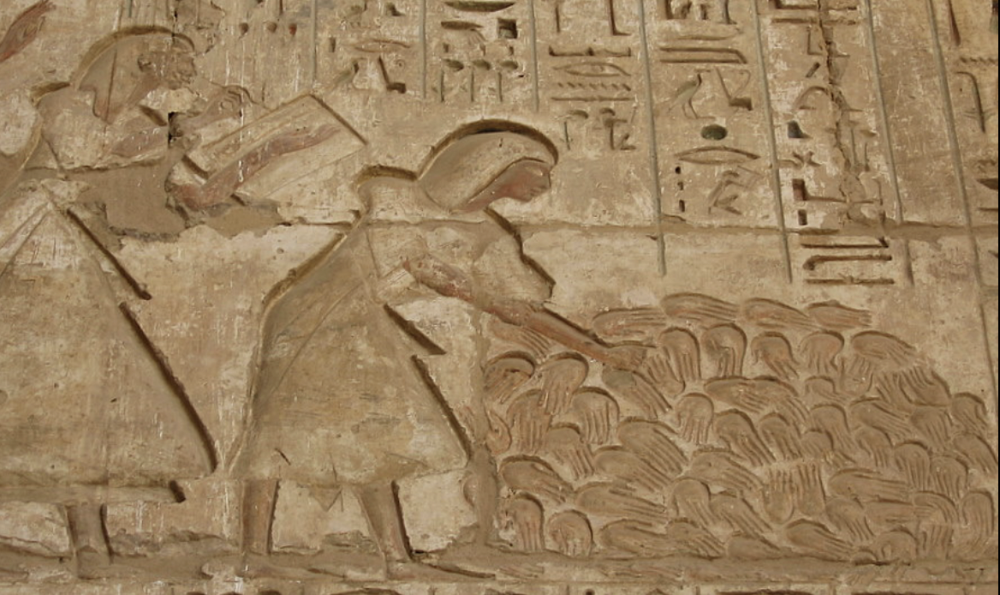
Medinet Habu Relief
Dynasty 20, Egypt
Ramses III
count dead by hands or pp --> hands easily doubles body count
demonstrates brutality
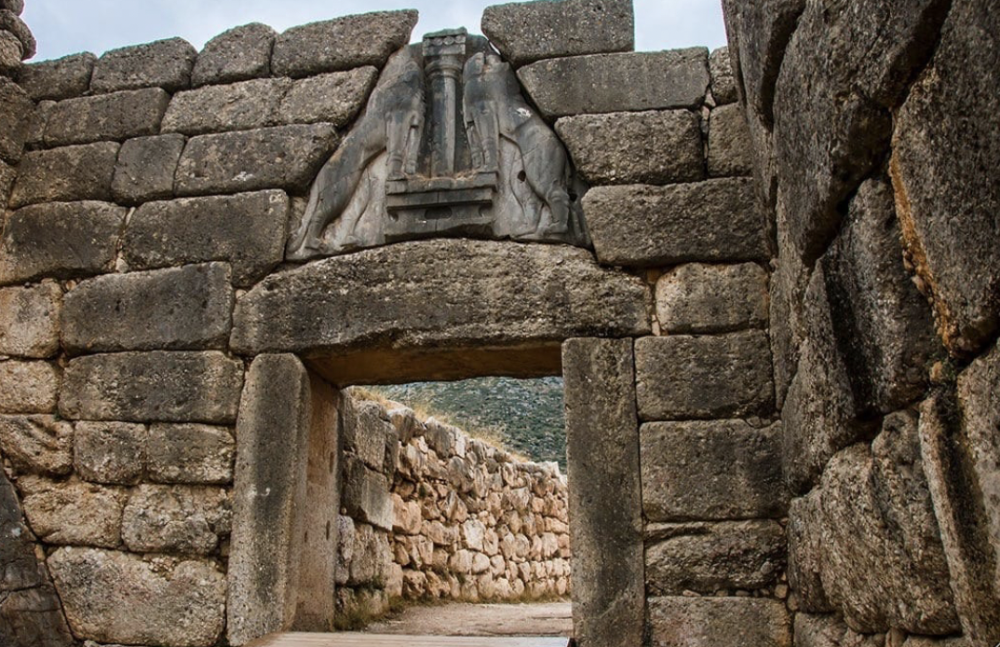
Lion Gate
Mycenaean (1250 BCE), ashlar masonry, Mycenae
main entrance
cyclopean masonry --> called this because did not believe ancestors had ability to make them so cyclops had
lions --> relieving triangle (receives pressure from lentel)
lions are strong and top of the food chain
missing their heads --> but if they did have a head there would be no mane

City of Mycenae
walls --> defensible (constantly preparing for attack, aerie is achieved through militaristic needs)
where there is "no wall" there is actually a cliff
made for seige
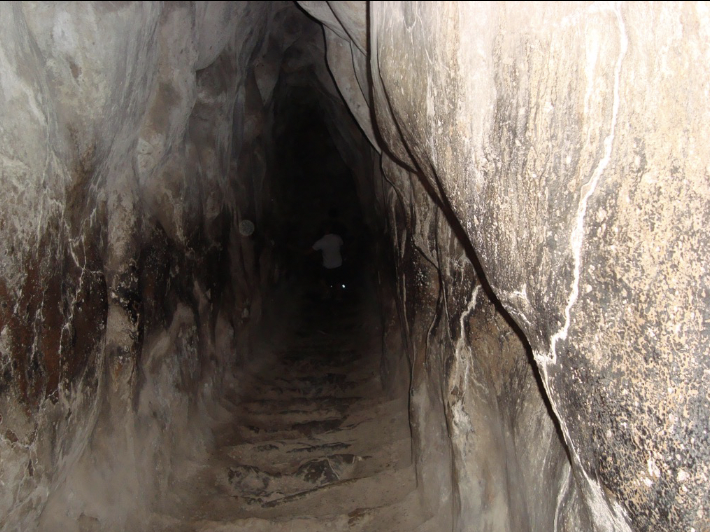
Cistern
Mycenaean, Mycenae
very dark
help with potential siege
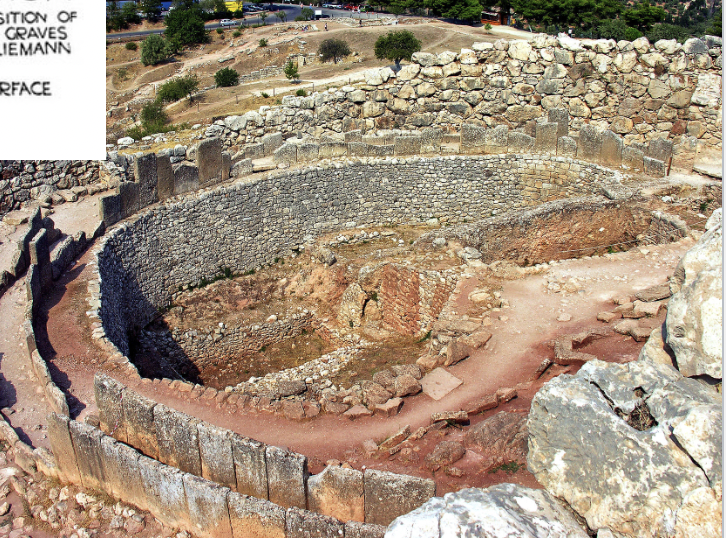
Grave Circle A
16th century BCE, Mycenae
6 shaft graves --> 19 bodies

Bull's head Rhyton
Mycenaean, gold and silver, Grave IV in Grave Circle A, Mycenae
used for liquid offerings --> poured out of mouth

Lion's head rhyton
Mycenaean, hammered gold, Grave Circle A, Mycenae

Mask of Agamemmon
Mycenaean (1550-1500 BCE), gold sheet, Grave V in Grave Circle A
peaceful --> closed eyes / grave smile
repousse for face and beard is chasing
gaslight Keiser Wilhem that he looks like this mask and make him believe he was destined to be a leader / king to get on his good side

Death Mask
Mycenaean (1650 BCE), gold, Grave Circle A
looks happy to be dead

Death Mask
Mycenaean, gold, Grave Circle A
most detailed --> has eyelashes and lips

Treasury of Atreus
Mycenaean (1250 BCE), Mycenae
dromos = road that leads to tomb --> like lion gate
not actually a treasury, a tomb --> tools tomb or beehive tomb in domestic monastery
earth built on top of structure
interior 13.5m high and 14.5m in diamter
corbel vault

posthumous 19th century CE portrait of Emperor Qin
Qin rules from 259-210 BCE --> believes legalism is law
Qin Dynasty (221-206 BCE) --> first unified state in China with centralized power and collapsed after his death (dies at 49 due to drinking mercury as medicine

Burial of Qin
1974, China
looks like a fake mountain
built earth structure
massive labor effort

Plan of Necropolis
Qin Dynasty, China
have not opened Qin tomb in central burial chamber --> would have to damage tomb otherwise get in, there is lots of mercury ion tomb, our air could damage it
necro = dead, polis = city
also tombs for attendant workers, animals, etc --> workers with Qin forever
as soon as state unified, this was built
walls were defensible
whole structure is apotropaic

War Chariot
Qin Dynasty (210 BCE), bronze, Mausoleum of Emperor Qin, China
similar to Buddha's riderless horse
mostly reconstructed --> brown spots are original
as close to burial chamber as possible --> easy access to after life

Terracotta Soldiers
Qin Dynasty, baked clay, China
in sita --> still where they were placed
plumbers likely builders of these soldiers
everything mold made, wait to mold becomes leather hard to add details, put pieces together, bake, then glaze and color
soldiers were polychrome --> paint fell off within seconds it touched our air
all soldiers individualized --> modular production (many different parts to mix and match --> maximizes variety)
not all life size, generally close to life size

Terracotta soldier army pits

Terracotta Army Pit 1
Qin Dynasty, baked clay, China
6,000 soldiers in military position with real weapons --> way to maintain order
outside in defensible edge
front is unarmored --> sacrifice / martyr
horseman always wins

Horseman
Qin Dynasty (5th - 3rd century BCE), China
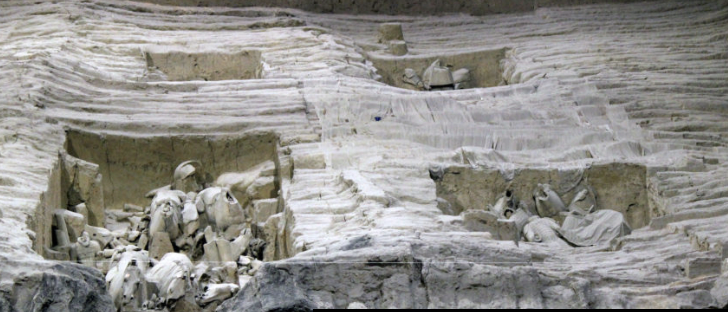
Terracotta Army Pit 2
Qin Dynasty, baked clay, China
1300 figures
specialized forces --> archers, chariots, cavalries

Terracotta Army Pit 3
Qin Dynasty, baked clay, China
68 soldiers
seems to be talking to each other / waiting to greet their commander
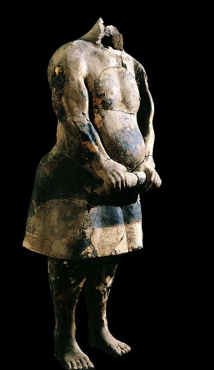
Terracotta "strongman"
Qin Dynasty, baked clay, China
likely an acrobat?
4th pit of Terracotta Army is entertainment / stuff for soldiers to do in their downtime
keep army happy --> keep following leader
describe the history of Greco-Persian war
classical period (480 - 300 BCE) right after archaic --> Greco-Persian war started this transition since Persians burned down Athens
many lived in Ionia --> Athens and Sparta support Ionia, but Persians get angry and invade
in 490 unified Greeks meet Persians in marathon city (Greek city and marathon city are 26.2 miles apart)
Greeks beat Persia --> Greece not unified, but unify to fight (similar to Trojan war)
only about 300 go and all die because Athenians do not fight during Olympics
Persians are in Athens from 480 - 479 BCE --> clear burn layer that shows when Persians were invading
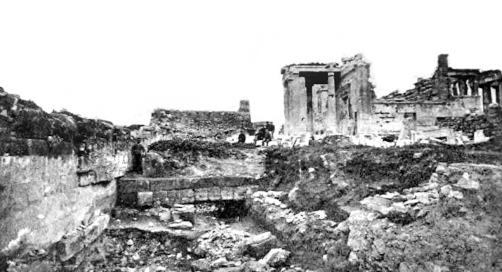
Perserchutt
Classical Period, Athens Greece
burn layer
excavated in 1866

Old Temple of Athena
Classical (480 BCE), Athens Greece
foudations
destroyed by army of Xerxes I
not rebuilt because its like a graveyard of people that died
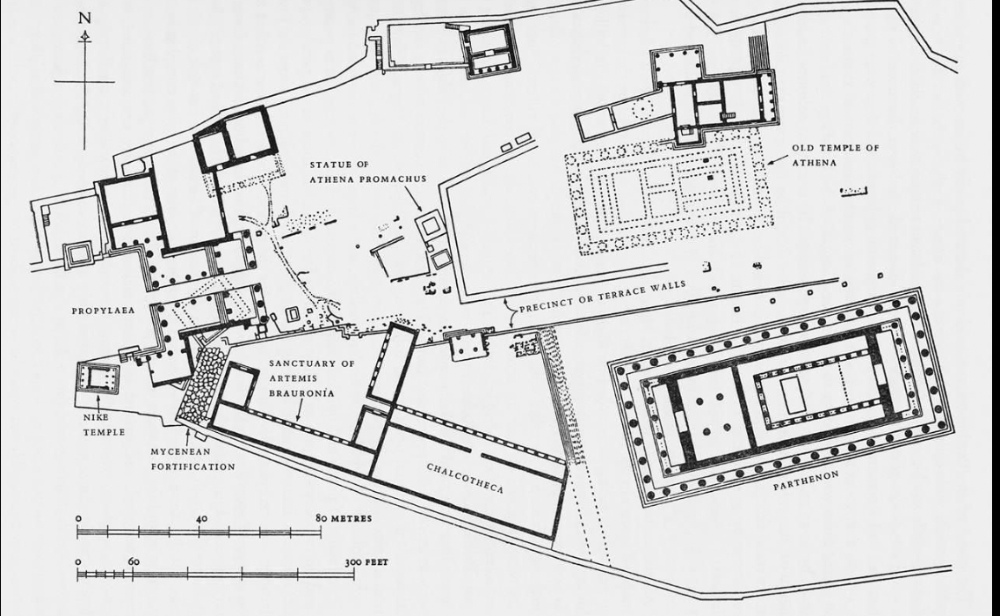
Plan of Acropolis
Classical (4th century), Athens Greece
parthenon --> dedicated to Athen Parthenon (Athena the virgin)
Athen pops out of Zeus' head in full armor

Plan of Parthenon
Classical, Athens Greece
1) Pronaos --> front porch
2) noas --> main room
3) chryselephantine Athena Parthenon --> cult statute room
4) treasury --> all wealth of Athens
5) adyton --> back porch

Parthenon
Classical (447-431 BCE), marble (local Greek stone), Athens Greece
Artists = Iktinos and Kallikrates
dedicated to Athena the virgin
built four decades after destruction
straight lines do not look straight to naked eye because our eyes are curved --> columns have entasis (bottom is subtly bigger than the top of column in order to look straight --> without this the parenthenon would look like it is caving in on itself)
obstacle refinement
would've been painted

What kind of style is this? what are the functions of these structures?
Octastyle --> 8 pillars in front
style = column
stylobate = base
doric columns = column
entablature = mental that connects posts of column
triglyphs and metopes = decorative
pediment = ?

Roman Copy of Phidias
Classical, chryselephantine (ivory and gold), 11m, Athens Greece
literary inscription of Pausanias
Athena Parthenos
Erichthonius = early king of Athens
contrapposto = right leg hold most of weight (bent) --> more natural than archaic stance (one foot in front of the other) and is NOT SEEN BEFORE 480 BCE
contrapposto = classical, archaic stance = one foot in front of other

Reproduction of Athena Parthenos
Nashville Tennessee
just gold
40 feet tall = intimidation

Ivory Head of Apollo
1995
possibly carved by Phidias
no emotion --> want to absolute control of emotions (no archaic smile!)

West Pediment of Parthenon
Classical (447-431 BCE), marble (local Greek stone), Athens Greece
all figures on pediment are same scale --> not are shrunk or made bigger to fit inside the pediment
west pediment is poorly reserved
shows contest between Athena and Poseidon --> Athen offers Olive Garden and Poseidon offers salt water
Athen wins (Athens)

East Pediment of Parthenon
Classical (447-431 BCE), marble (local Greek stone), Athens Greece
shows birth of Athena --> rising sun on one side, moon setting on other
no nude women until 320 BCE

what is this type of architecture called?
wet drappery --> conceals everything but is also very revealing
backs are carved and not left blank --> shows respect to gods but also strive for optical perfection
this is a temple for Athena, it needs to be perfect, although humans can't fly up to see the backs of the statues, Athena could

Metope on Parthenon
west = amazon ally --> woman warrior
south = Lapiths and centaur
east = gigantomachy
north = trojan war

Metope of Lapith and Centaur

Frieze of Parthenon
everyone participate in ritual of procession
pan-artheraic parade
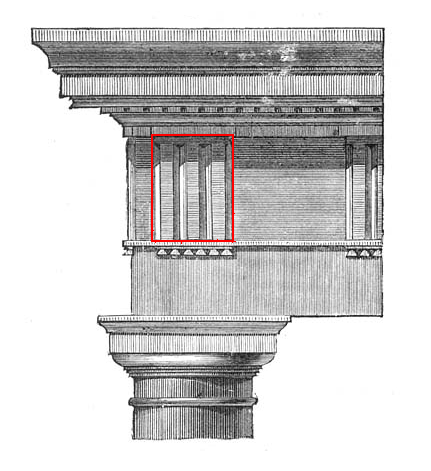
Trioglyph of parthenon

briefly explain the history of Teotihuacan
200 BCE
massively burned in 650 CE
when the Aztecs arrive in 1325 it is abandoned
no writing system in Teotihuacan so all the names are Aztec influenced

Teotihuacan city
teatl = Nahuatl (Aztec language) signifying defied entitiy
divided into ethnic neighborhoods

"Avenue (or Way) of the Dead"
Teotihuacan, Mexico
4 miles that that leads to the Temple of the Moon
niches in the wall for mummies to lay standing up
3 types of people that live there --> super-elites, elites, and everyone else
richer people lived closer to way of the dead
650 houses burned down in this area --> none were poor (poor class burned down the houses)

Temple of the Moon
Teotihuacan, Mexico
Performance / ritual area --> stage and smaller pyramids (very big on being seen and public spectacle)
pyramid mimics the earth --> geomancy = built environment aligns with natural world
solar alignments (makes good astronomical observations --> like Stonehenge) --> high up and raised and when standing on platform there is no obstruction of view
7 construction phases --> all built around old temple (build outwards and in between each phase is buttressing stone and rubble
past phases are preserved
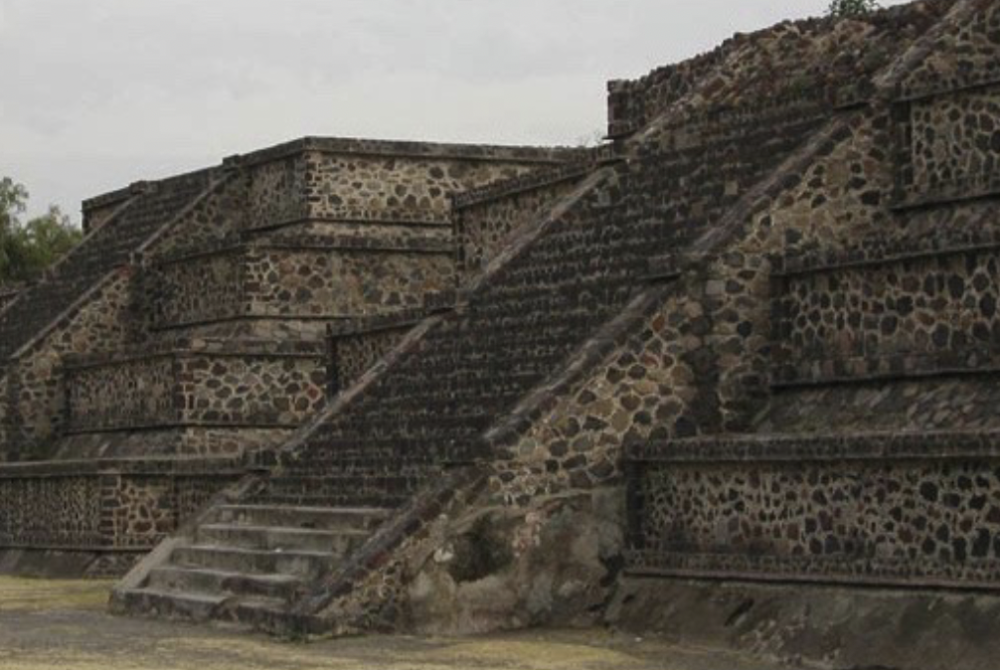
Talud-Tablero
Teotihuacan, Mexico
diagnostic indicator of Teotihuaconic presence
see influence of architectural style
discreet terraces --> each platform of pyramid
talud = slope --> less exaggerated on inside
tablero = table / flat surface

Tetitla Great Goddess
Teotihuacan (500 CE), Mexico
interested in nature, not naturalism
looks like a human dressed up as goddess --> real human face
polychromatic color palette --> green / blue / red = fertility
on talud
ear spools, green / blue bird headers, water issuing from hands, and fangs
hybridized goddess
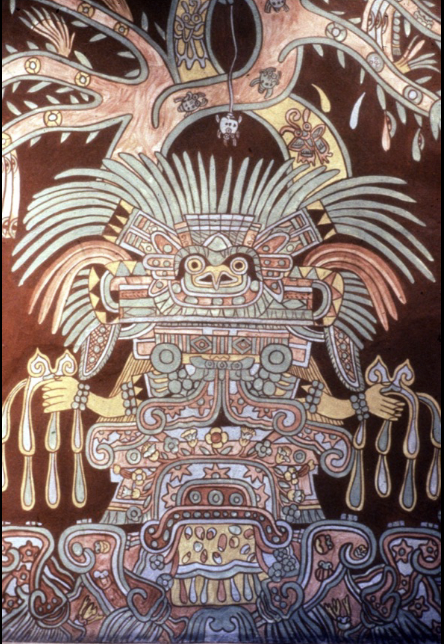
Tepantitla Great Goddess
Teotihuacan, Mexico
sitting in fertility cave / tree growing out = fertility goddess
shows actual deity
great spider goddess --> creation and destruction (gods sacrifice themselves in order to create
ear spools, green / blue bird headers, water issuing from hands, and fangs

Great Goddess Sculpture
Teotihuacan
very simple

Tlaloc
Teotihuacan, Mexico
bug eyes and barbs like catfish
mini version of himself in his hadns
on tablero
in realm of tlaloc --> dancing and singing = swirls out of mouth

Colossal Statue of Constantine the Great
325 CE, marble, Rome
first emperor to be christian --> had to be hidden, not allowed to be Christian before him
big eyes --> look heavenward like Alexander (also a dedication to heaven)
braided hair crown --> bowl cut
beardless and cleft chin

Basilica of Santa Sabina (outside)
5th century (432 CE), Rome
plain boring and weathers

Basilica of Santa Sabina (inside)
5th century (432 CE), Rome
apse, side aisle and nave --> no transept!
plain / empty
original 5th century wooden ceiling
spolia = wholesale reusing an object (parts of Roman buildings --> columns)
clerestory windows = let large amounts of lights in --> feels like heaven

Santa Sabina Doors
5th century (430-432 CE), cypress, Rome
show stories form old and new testament
bottom of doors (7 panels) are weathered from touch

Elijah ascends bodily into heaven
like Mary and Jesus
Sanat Sabina doors

earliest depiction of crucifixion
Santa Sabina doors
Jesus always beardless and a good shepherd in Dura Europa
scary / hieratic scale
bearded and long hair
brick wall behind him --> carpentry? show it was in Rome?

Basilica of Santa Maria Maggiore (outside)
5th century (432-440 CE), Rome

Basilica of Santa Maria Maggiore (inside)
5th century (432-440 CE), Rome
apse = extravagant --> triumphal arc mosaic
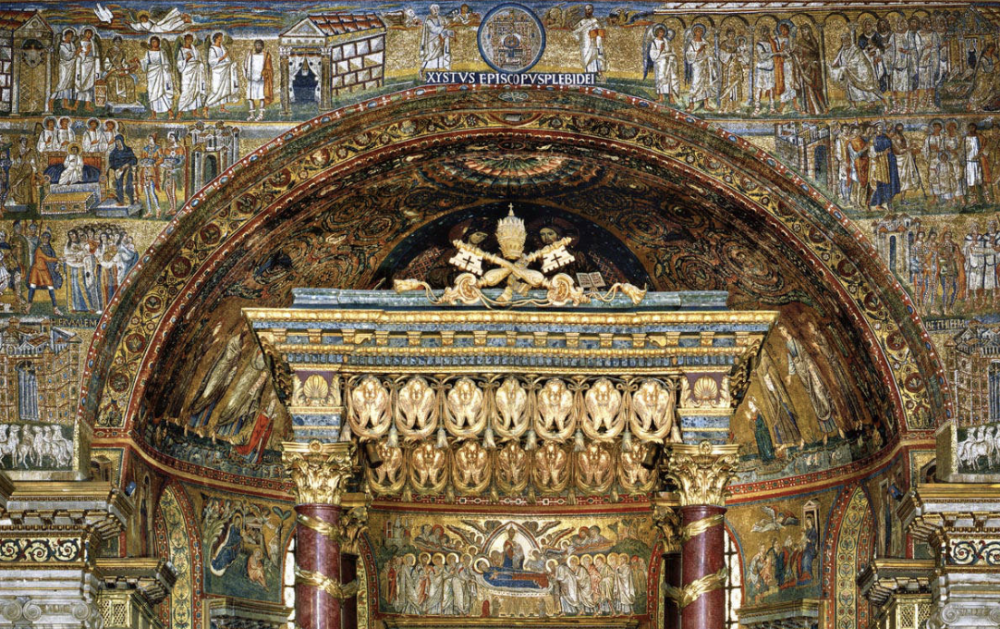
Triumpha Arch Mosaics
5th century (432-440 CE), Santa Maria Maggiore in Rome
similar to Arch of Titus in Rome that shows victory over Jesus
Arch shows spiritual victory, not earthly viceroy --> victory of Christ over death
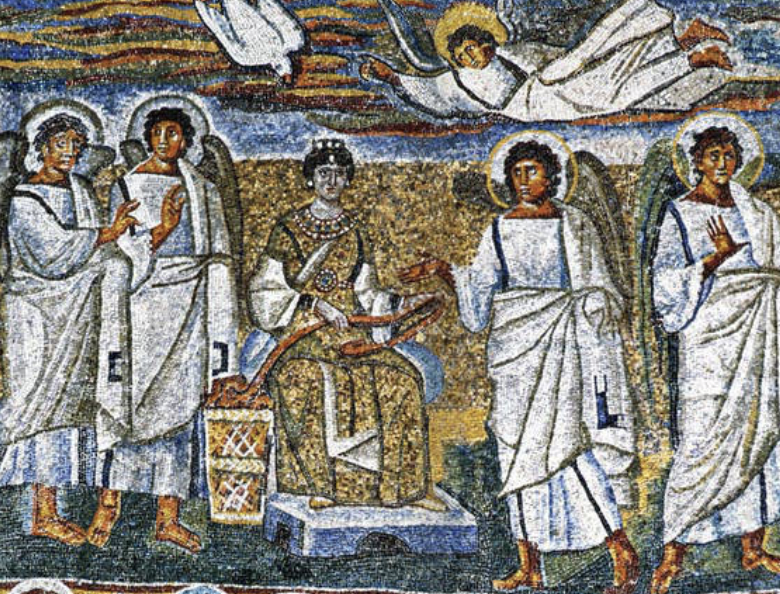
Annunciation on Triumphal Arch Mosaic
5th century (432-440 CE), tesserae, Santa Maria Maggiore in Rome
upper left of arch
tesserae = individual squares in mosaic
dove = holy spirit
Mary dressed as Byzantine empress
angels wearing togas --> upper-class roman wear togas

4 Evangelists on Triumphal Arch Mosaic
5th century (432-440 CE), tesserae, Santa Maria Maggiore in Rome
in order form left to right: Luke, Matthew, Mark, John
Peter on left --> goes west to spread Christianity (white hair)
Paul on right --> goes east to spread Christianity (bald and behaeaded)
Mary - chair, Jesus = cross
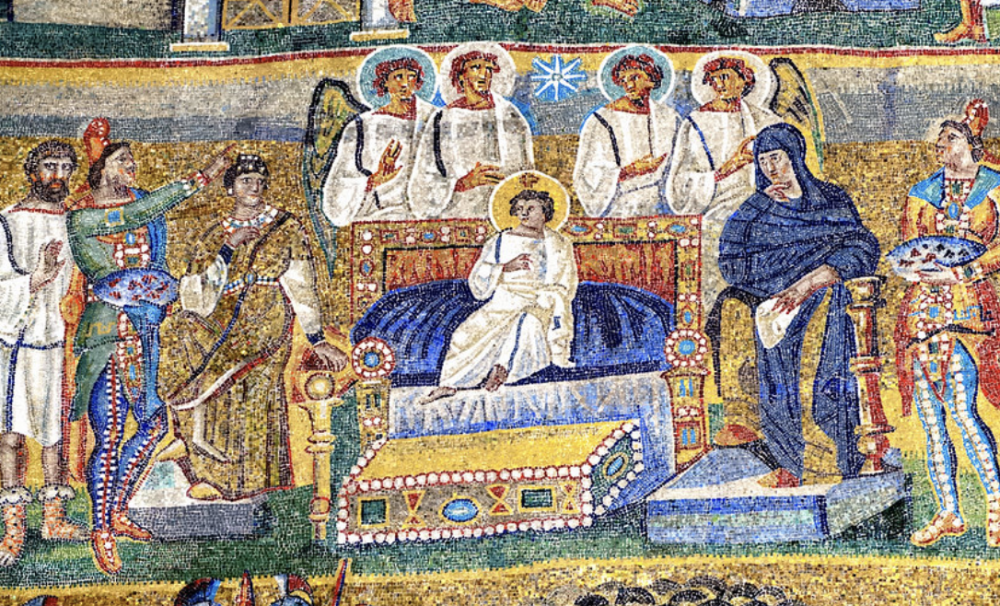
Epiphany on Triumphal Arch Mosaic
5th century (432-440 CE), tesserae, Santa Maria Maggiore in Rome
Magi dressed like clowns --> eastern clothes
Mary is both in yellow and blue (regular person on Eartha nd empress in heaven)
embalming spices --> Jesus is gin to die


Church of San Vitale (outside)
548 CE, Ravenna Italy
centrally planned --> similar to grave of holy figures (circular buildings mark graves)
apse in the front
narthex = entrance hall
ambulatory = able to walk around --> in a circle
not decorated outside

Church of San Vitale (inside)
548 CE, marble, Ravenna Italy
very decorated
butterfly looking thing is able resentment
6th century alabaster windows --> gold and glowing on the inside
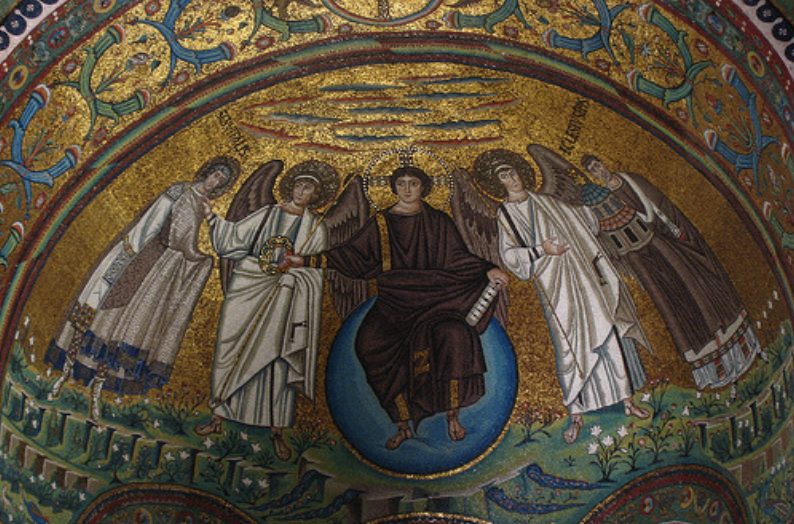
Apse Mosaic
548 CE, Church of Santa Sabina in Ravenna Italy
Jesus with cruciform halo --> sitting on earth to show he knows everything about it
angels dressed in togas to represent language of Rome --> Jesus purple toga
far right = local bishop --> donated land for local church

Justinian Apse Mosaic
548 CE, north wall of Church of Santa Sabine in Ravenna Italy
Justinian in center with halo --> red shows to symbolize authority
on his right is clergy --> cross, book, incense
on his left is military --> shows he is supported by church and state
participating in the euchatist
need = bishop who was in Ravenna when it was built
shield has Cairo (p with x)

Theodora Apse Mosaic
548 CE, south wall of Church of Santa Sabine in Ravenna Italy
only Theodora painting we have
supposed by ladies in witing
fountain = baptismal font
holding chalice --> participating in the eucharist
Theodora grows up poor and on a bear farm?
hem of dress = magi
looks like Mary dressed as a byzantine empress

Justinian moves Roman capital to Constantinople
Justinian always here, never in Ravenna
Hagia Sophia is burned down --> Justinian rebuilds it in spite of civilians

Church of Hagia Sophia (outside)
(532-537 CE), istanbul Turkey
basilica style church

Church of Hagia Sophia (inside)
(532-537 CE), istanbul Turkey
3rd story windows --> light = presence of God
massive (186 ft high)
gold = think you are in realm of heaven
roman arch is strongest form in architecture --> build pillars curving up equally on both sides and then connect them

left = squint --> square base the dome sits on
right = pendentive --> downward sloping to send the force down

dome of Hagia Sophia Chruch
dome collapsed in 538 that was built by Isidore and rebuilt in 562
dome angle is moved upward and ribs added to help transfer to squelch and force pressure down --> holes in the dome make the dome weaker
changed to a mask --> covered preexsiiitng mosaics like Mary and Jesus in the apse (only faces are covered, i.e. wings from seraphim's are kept)